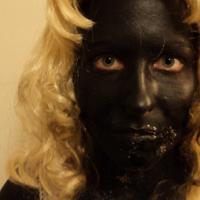The power others have over the identity of an individual is an absolute force of authority. If the community wills it, a person can be completely stripped of their sense of both identity and self. This is an archaic dynamic between outcast and community, victim and perpetrator that stems back to the creation of society. This series of performances entitled Pariah concentrates on what the pariah becomes in the moment of complete and utter degradation where even the right to its humanity has been taken away.
Pariah inhabits the space not as an individual but as an emblem of the human it used to resemble. The performance focuses on the moment of no return, encapsulating the searing emotion of a person spurned. It is a consistent, endless stretch of time without climax. Pariah is alert and intelligent, confronting anyone nearby with a penetrating stare that forces the viewer into an acute sense of the uncanny. Therefore, the creature isolates itself from the surrounding crowd using its very presence, cementing its situation in both the literal and figurative realm.
Beyond the limited movement and stillness the pariah uses to interact with its space, the performance uses a compilation of identities and historic signifiers to invoke the feel of the stoned, raped, burned, tarred and feathered. The coal black skin and tangled, fake blonde hair affirm the fickle nature of the masks we build for ourselves and the more often lethal masks our peers project onto us for purposes of gain and power. The use of black for the pariah’s body has a layered meaning. While it represents the archaic whore that has been burned at the stake, or doused in boiling tar, it also beckons back to a period of history whose ramifications are still felt today.
Consider the infamous stigma of blackface and vaudeville. White society used the mask of blackface to humiliate the black community and to maintain control during a period of change in American culture. The negative stereotypes spread by this mask have caused lasting damage. By incorporating black face into this performance Pariah is making a poignant comment on the painful nature of humiliation and self-reflection on societies past transgressions.
Beyond the visual signifiers, the essential role time plays with each performance is, if not equal, then surpasses the importance of the actual, physical event itself. The entirety of the concept that this work embodies is based on the aftermath of violent moments. These moments do not leave behind obvious evidence. Like a hate crime sprung from ignorance and fear, there is rarely more than a victim, or a corpse, and talk that works its way using whispers and gossip to spread through a community. Outsiders to the event only catch scraps of information. There is only an impression left behind by the violence.
The timing of these moments is vital. Pariah does not have documentation presented as an aid to view the performance. There is the schedule, the name, and if the viewer’s timing lines up, they see and experience the pariah’s presence. Consequently, there are two experiences that the viewer will have with the piece. They will either experience the performance, or they will not. However, this is not to say that the viewer will be denied any sort of experience if they miss the performance. Missing the event itself is part of the work and, while different in its overall emotional pull, achieves an equally poignant sense of distance and fascination that facing the pariah in the flesh invokes.
Time is the absolute barrier that can separate an individual from an event. By selectively leaving the wall bare other than the performance announcement, I am isolating the viewer. The viewer that realizes that they’ve missed Pariah becomes the outsider that hears talk of an act of violence. The scheduled, continuative nature of the performance series serves to enforce the consistent, endless loop that both the viewer, as witness or outsider, and the pariah engage in. Every viewer has a personal emotion or memory relatable to the fear and pain a pariah embodies. As a result, Pariah becomes a multifaceted approach to how we, as both a society and as individuals, cope with our own identities and that of the forsaken.



